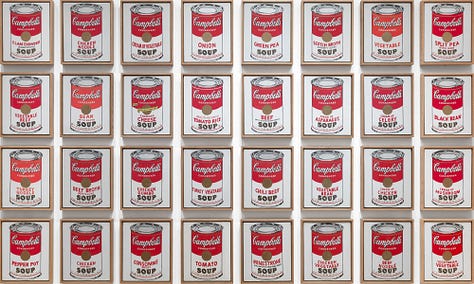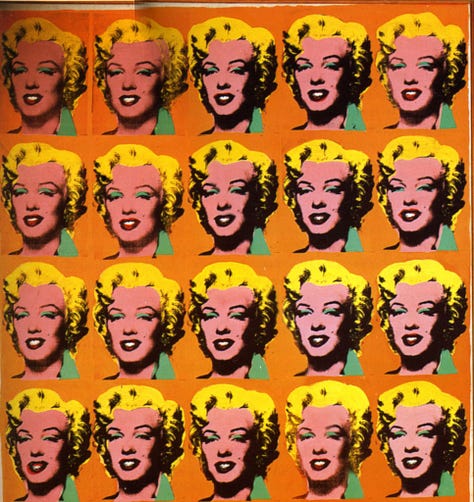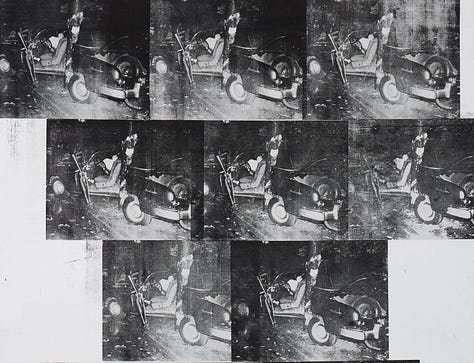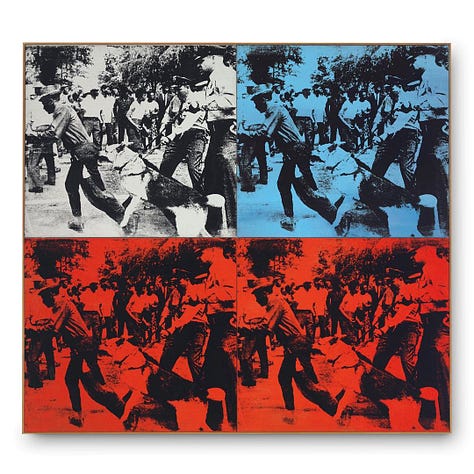Andy Warhol (1928–1987), a leading figure in the Pop Art movement, has left an indelible mark on the history of contemporary art. Known for his exploration of consumerism, celebrity culture, and mass production through works such as Campbell's Soup Cans (1962) and Marilyn Diptych (1962), Warhol's persona often overshadows his more personal struggles, including his battle with addiction. Warhol's addiction, particularly with drugs, was emblematic of the tumultuous nature of the New York art scene of the 1960s and 1970s. #NationalRecoveryMonth
Born in Pittsburgh, Pennsylvania, in 1928, Andy Warhol (originally Andrew Warhola) came from a working-class immigrant family of Slovak descent. His early life was marked by illness, isolation, and an intense fascination with popular culture, which would later influence his work. After moving to New York City in 1949, Warhol became a successful commercial illustrator before transitioning to fine art in the early 1960s.
Warhol’s fascination with celebrity culture and fame can be traced to his early admiration for Hollywood and mass media. However, his ascent to fame was accompanied by personal insecurities and an increasing dependency on external substances to cope with the pressures of his public image, fame, and the chaotic nature of the art world.
While Warhol's public persona was one of detachment and aloofness, behind the scenes, his relationship with drugs reflected a more vulnerable and troubled aspect of his life. Warhol was not publicly known for abusing substances to the same degree as some of his contemporaries, such as Jean-Michel Basquiat, yet his engagement with the drug culture of his time was significant. Warhol’s relationship with amphetamines (commonly known as "speed") was well-documented by those who frequented The Factory, Warhol's famed studio, which served as a hub for artists, musicians, and cultural figures.
Amphetamines, popular among the bohemian and artistic circles in New York during the 1960s and 1970s, allowed individuals to work long hours and suppress their appetite. For Warhol, whose work often involved repetitive tasks such as screen printing and film editing, amphetamines provided the stamina and focus necessary for prolonged creative output. However, the drug's effects extended beyond his artistic productivity.
Warhol’s use of amphetamines coincided with a period of intense artistic activity but also a growing sense of paranoia and emotional instability. His dependence on these substances mirrored the darker undercurrents of the Pop Art movement, where the superficiality of consumer culture was both celebrated and critiqued. The disjunction between Warhol's seemingly emotionless public persona and his private struggles with addiction reveals the complexities of his character and the ways in which his art can be interpreted.
Warhol's studio, The Factory, was not only a space for art-making but also a gathering place for the avant-garde and the countercultural movements of the time. The Factory became infamous for its hedonistic parties, where drugs like amphetamines, LSD, and other substances were readily available. The Factory regulars, including Warhol’s “superstars” such as Edie Sedgwick and Ondine, were often caught up in a cycle of drug use that fueled both their creative endeavors and personal downfalls.
Warhol's film projects during the mid-1960s, such as Chelsea Girls (1966), often depicted the drug-fueled lives of Factory denizens. These films, characterized by their raw and voyeuristic quality, blur the line between reality and fiction, and between Warhol as artist and Warhol as documentarian of a self-destructive milieu. The presence of drugs in these films reflects both the allure and the dangers of addiction, capturing a cultural moment where artistic experimentation and substance abuse were intimately intertwined.
Although Warhol himself never admitted to severe drug abuse, those close to him have spoken about his frequent use of amphetamines, which allowed him to sustain the high levels of productivity for which he was known. However, this addiction also contributed to his increasing detachment from those around him. Warhol’s emotional distance from his subjects, both in his art and personal life, can be seen as a defense mechanism, exacerbated by his drug use. The superficiality and repetition in Warhol’s work may, in part, be interpreted as a manifestation of his attempts to shield himself from the vulnerabilities and anxieties he faced in his personal life.
Warhol’s relationship with drugs raises important questions about the role of addiction in artistic production. The obsessive, repetitive nature of his works—such as his silkscreen prints of celebrities—can be understood as both a reflection of the mass-production techniques of consumer culture and an embodiment of the compulsive behaviors associated with addiction. In works like his series of self-portraits from the 1980s, Warhol presents a more introspective side of himself, grappling with mortality and the frailty of the human body—perhaps a reflection of his own deteriorating health due to years of drug use and the lingering effects of being shot by Valerie Solanas in 1968.
Additionally, Warhol’s series Death and Disaster (1962–1964), which includes images of car crashes, suicides, and electric chairs, can be interpreted as meditations on mortality and the darker aspects of human existence. These works, produced during a period of intense amphetamine use, suggest a connection between Warhol’s drug addiction and his preoccupation with death, violence, and tragedy. The repetitive use of traumatic imagery in these works parallels the repetitive behaviors often associated with addiction, where one becomes trapped in a cycle of consumption and destruction.
Warhol’s struggles with addiction are an important aspect of his life and work that continue to shape interpretations of his artistic legacy. While he successfully maintained a prolific career, his relationship with drugs highlights the tensions between creativity and self-destruction that have plagued many artists throughout history. Warhol’s addiction, while often overshadowed by his artistic achievements, offers insight into the psychological complexities that underlie his seemingly detached and mechanized aesthetic.
Warhol’s life and work continue to provoke discussions about the role of addiction in the art world. His ability to blend the personal with the universal, the banal with the profound, and the real with the artificial remains one of the defining features of his work. By examining his struggles with addiction, we gain a deeper understanding of the psychological undercurrents that shaped his art and the cultural context in which he lived and worked.
Andy Warhol’s addiction struggles, particularly with amphetamines, were both a product of and a contributor to the frenetic energy of the New York art scene during the 1960s and 1970s. His drug use was emblematic of a broader culture of experimentation and excess, yet it also reflected his personal insecurities and emotional vulnerabilities. Warhol’s art, often characterized by its detachment and repetition, can be viewed as a manifestation of his attempts to cope with these struggles. Through his work, Warhol not only captured the spirit of his time but also revealed the darker, more complex aspects of fame, addiction, and the human condition.
References
Bockris, Victor. Warhol: The Biography. Da Capo Press, 2009.
Bourdon, David. Warhol. Abrams, 1995.
Colacello, Bob. Holy Terror: Andy Warhol Close Up. HarperCollins, 1990.
Gopnik, Blake. Warhol: A Life as Art. Penguin Press, 2020.
Koestenbaum, Wayne. Andy Warhol. Penguin Lives, 2001.
Prince, Richard. “The Drug of Choice: Andy Warhol's Speed Freaks and Addicts.” Artforum, vol. 37, no. 3, 1999, pp. 116-123.










Scenes like that are incredibly intense at the time and the rest of us only get to to see artifacts. Velvet Underground songs that don't get airplay unlocked it for me. This is my favorite.
https://music.youtube.com/watch?v=aNSH8OdHx2A&si=rGE-dd5g2uGwFrYU